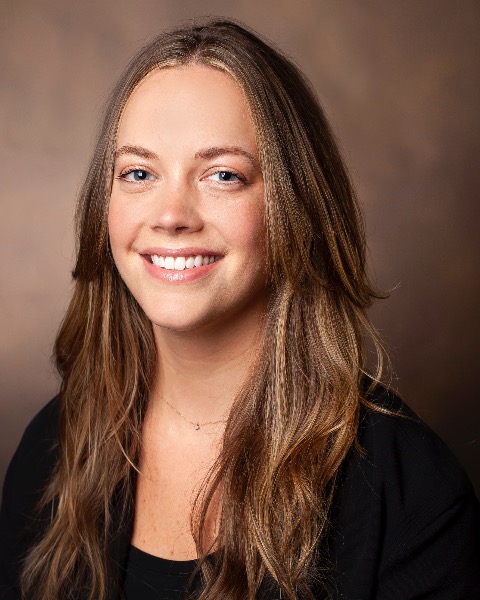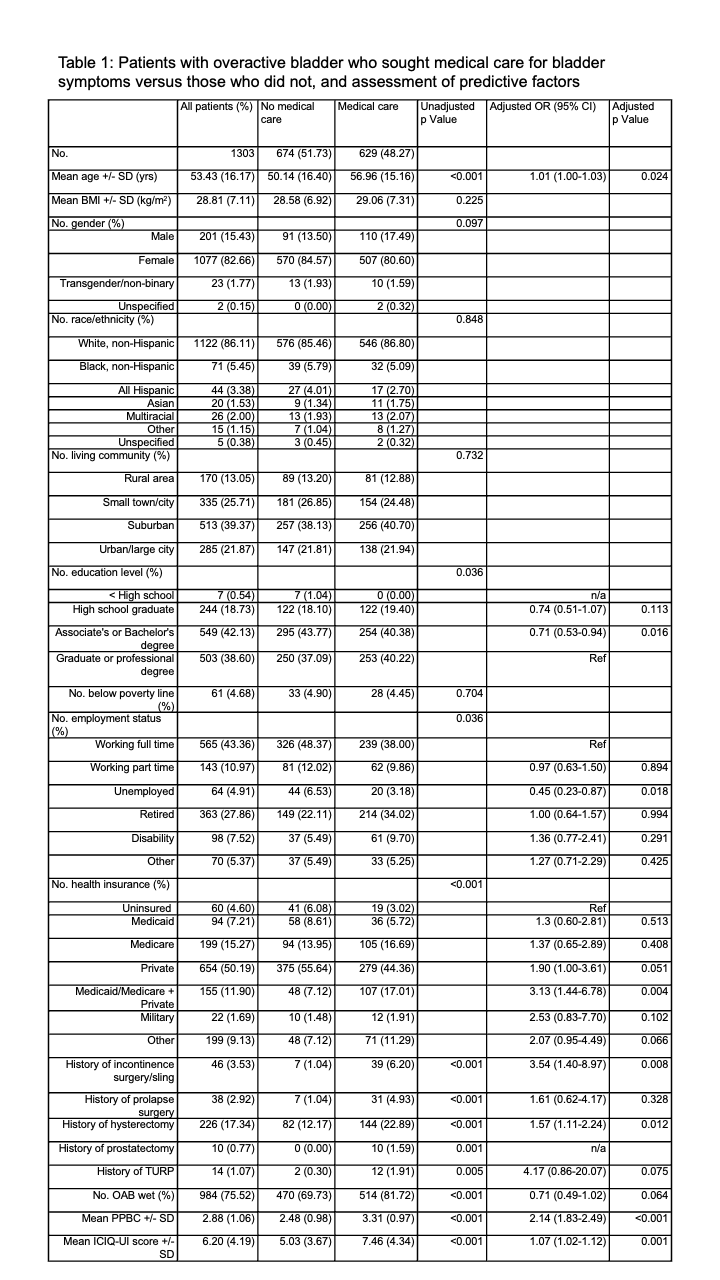Back
Poster, Podium & Video Sessions
Moderated Poster
MP18: Urodynamics/Lower Urinary Tract Dysfunction/Female Pelvic Medicine: Non-neurogenic Voiding Dysfunction I
MP18-12: Assessing the utilization of the healthcare system in patients with overactive bladder
Friday, May 13, 2022
4:30 PM – 5:45 PM
Location: Room 222
Elisabeth Sebesta*, Stephanie Gleicher, Melissa Kaufman, Roger Dmochowski, W. Stuart Reynolds, Nashville, TN

Elisabeth Sebesta, MD
Vanderbilt University Medical Center
Poster Presenter(s)
Introduction: Overactive bladder (OAB) is common and represents a significant healthcare burden. It is not known how many patients with OAB seek out medical care for or are treated for their condition. The objective of this study was to assess the proportion of patients who sought out medical care and received treatment for bladder symptoms, in addition to any predictive factors for seeking medical care.
Methods: A sample of 3,396 adults was recruited electronically to complete a questionnaire on clinical and demographic information, social needs, and urinary symptoms (LURN SI-10, ICIQ-UI SF, and PPBC). Participants were excluded if currently pregnant, had a history of cystectomy, pelvic radiation, or neurologic lower urinary tract dysfunction. Descriptive statistics were performed, in addition to uni- and multivariable logistic regression to assess for predictive factors for seeking out medical care.
Results: 1,303 participants (38.4%) were identified with OAB (any urge incontinence in 1 week or urgency with frequency >8 times/day). Most identified as female (82.7%) and white, non-Hispanic (86.1%). Respondents mostly lived in a suburban community (39.4%), had private insurance (50.2%), worked full time (43.5%), and had at least a college degree (42.1%). The majority reported their last doctor’s visit for any reason was within a year (94.7%), however, only 48.3% of patients reported ever asking a doctor about bladder symptoms. Finally, only 135 (10.4%) patients reported taking bladder medications. On logistic regression, older age, history of urologic surgery, having both Medicare/Medicaid and private insurance, and increased symptom severity were predictive of having asked a provider about urinary symptoms (Table 1). Unemployed patients and those with a college degree were less likely to see a physician.
Conclusions: In this cohort, only half of those with clinical OAB have discussed urinary symptoms with a provider, and a smaller proportion treated with oral medications. Those more likely to seek medical care had prior urologic surgery, indicating patients that are already receiving urologic care, in addition to increased symptom severity. Further research is needed to determine barriers that prevent patients from seeking care for OAB, and how as providers we may more effectively reach these patients.
Source of Funding: UL1 TR000445 from NCATS/NIH

Methods: A sample of 3,396 adults was recruited electronically to complete a questionnaire on clinical and demographic information, social needs, and urinary symptoms (LURN SI-10, ICIQ-UI SF, and PPBC). Participants were excluded if currently pregnant, had a history of cystectomy, pelvic radiation, or neurologic lower urinary tract dysfunction. Descriptive statistics were performed, in addition to uni- and multivariable logistic regression to assess for predictive factors for seeking out medical care.
Results: 1,303 participants (38.4%) were identified with OAB (any urge incontinence in 1 week or urgency with frequency >8 times/day). Most identified as female (82.7%) and white, non-Hispanic (86.1%). Respondents mostly lived in a suburban community (39.4%), had private insurance (50.2%), worked full time (43.5%), and had at least a college degree (42.1%). The majority reported their last doctor’s visit for any reason was within a year (94.7%), however, only 48.3% of patients reported ever asking a doctor about bladder symptoms. Finally, only 135 (10.4%) patients reported taking bladder medications. On logistic regression, older age, history of urologic surgery, having both Medicare/Medicaid and private insurance, and increased symptom severity were predictive of having asked a provider about urinary symptoms (Table 1). Unemployed patients and those with a college degree were less likely to see a physician.
Conclusions: In this cohort, only half of those with clinical OAB have discussed urinary symptoms with a provider, and a smaller proportion treated with oral medications. Those more likely to seek medical care had prior urologic surgery, indicating patients that are already receiving urologic care, in addition to increased symptom severity. Further research is needed to determine barriers that prevent patients from seeking care for OAB, and how as providers we may more effectively reach these patients.
Source of Funding: UL1 TR000445 from NCATS/NIH


.jpg)
.jpg)